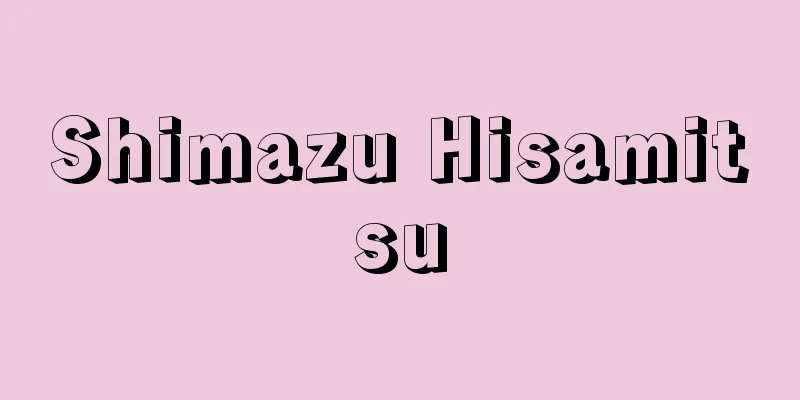Shimazu Hisamitsu

|
Year of death: December 6, 1887 Year of birth: Bunka 14.10.24 (1817.12.2) A leader of the Satsuma Domain during the late Edo period. His father was Shimazu Narioki, the lord of the domain, and his mother was concubine Yura. His pen names included Somatsu, Daikan, Ganko Dojin, and Musho. A dispute arose over the succession of Narioki, with Hisamitsu and his half-brother Nariakira supporting each other (known as the Oyura Disturbance, the Takasaki Collapse, and the Kaei Hoto Incident), but Nariakira eventually succeeded, and then, according to Nariakira's will, Hisamitsu's biological son Tadayoshi became the lord of the domain. Shortly after his birth, Hisamitsu was adopted by the lord of Tanegashima, but later returned to the main family, and was adopted by Shimazu Tadakichi, a member of the clan, and in 1839 inherited 14,000 koku of land in Shigetomi, Osumi Province. With the arrival of foreign warships during the Koka era (1844-48), he began to participate in domain politics. Upon returning to his family at the request of Tadayoshi, who had become the lord of the domain, he was called the father of the nation and took control of the real power of the domain's government. In the political situation after the country was opened to the world, he selected Okubo Toshimichi from among the young men of the so-called Seichugumi group who advocated sonno joi (the expulsion of the Emperor and the expulsion of the people), and sought to participate in central politics. In Bunkyu 2 (1862), he ordered Saigo Takamori to lead the advance (Saigo was later exiled for heading to Kyoto on his own initiative), and led his troops to the capital. Following Nariakira's last wishes, he envisioned a union of the Imperial Court and the Shogunate, suppressed the Sonno joi extremists within the domain in the Teradaya Incident (1862), and then accompanied the imperial envoy Ohara Shigenori to Edo, where he contributed to the reform of the shogunate government, such as the appointment of Hitotsubashi Yoshinobu as guardian of the shogun. On his way back, he caused the Namamugi Incident, which led to the Anglo-Satsuma War (1863) the following year, but the Satsuma army's brave fighting was commended by the Imperial Court for its efforts in expelling the expulsion of the people. After the Anglo-Satsuma War, he led the August 18th Coup and was added to the Sanyo Kaigi (Councillor's Conference), and continued to aim for the union of the Imperial Court and the Shogunate, but the dissolution of the conference put him at a standstill. To break the impasse, he employed Okubo and the pardoned Saigo, but in the end, the union of the Imperial Court and the Shogunate gradually retreated, and the way was opened to the overthrow of the Shogunate. After the Meiji Restoration, he maintained a conservative tendency and criticized the new government's liberal policies, and in 1872 (Meiji 5) he made a petition to that effect in Kagoshima during a tour of the Emperor. After Saigo resigned from his post, he went to Tokyo in 1873 and was appointed as a Cabinet Advisor, and the following year he was appointed as Minister of the Left, but he eventually resigned and returned to Japan after submitting a petition criticizing the Westernization policy and Sanjo Sanetomi and Iwakura Tomomi. During the Seinan War (1877), he showed no sign of supporting Saigo's forces. In 1882 he became a duke, and in his later years he worked on compiling history. <References> Shimazu Duke Family Editorial Office, "Shimazu Hisamitsu Jikki" (Junichi Nagai) Source: Asahi Japanese Historical Biography: Asahi Shimbun Publications Inc. About Asahi Japanese Historical Biography |
|
没年:明治20.12.6(1887) 生年:文化14.10.24(1817.12.2) 幕末の薩摩藩指導者。父は藩主島津斉興,母は側室由羅。号は双松,大簡,玩古道人,無志翁など。斉興の継嗣をめぐり久光と異母兄斉彬のそれぞれを擁立する抗争(お由羅騒動,高崎崩れ,嘉永朋党事件などと称する)を生じたが,結局斉彬が嗣ぎ,次いで斉彬の遺命により久光の実子・忠義が藩主となる。久光は生後間もなく種子島領主の養子に出されたが,のちに本家に戻り,さらに一門の島津忠公の養子となり天保10(1839)年大隅国重富領1万4000石を相続した。弘化年間(1844~48)に外国軍艦の来航する事態を迎えて藩政に参与し始める。藩主に就任した忠義の要請で本家に復帰すると,国父と称され藩政の実権を掌握した。開国後の政治情勢の中で尊攘を唱える,いわゆる誠忠組の青年の中から大久保利通を抜擢し,中央政局への参加を図った。そして,文久2(1862)年西郷隆盛に先発を命じ(西郷はのち独断で京を目指したため遠島処分),率兵上京した。斉彬の遺志を継いで公武合体を構想し,寺田屋騒動(1862)で藩内尊攘激派を弾圧し,次いで勅使大原重徳を奉じて江戸に行き,一橋慶喜の将軍後見職就任などの幕政改革に寄与した。その帰途生麦事件を起こし,翌年薩英戦争(1863)を招いたが,薩摩軍の勇戦により朝廷から撃攘の功を賞されている。 薩英戦争後,8月18日の政変を主導し参予会議に加えられ公武合体を目指し続けたが,同会議の解消により行き詰まってしまった。難局打開のため大久保と赦免した西郷を用いたが,結局,両人により公武合体は次第に後退し,倒幕への道が開かれた。維新後,守旧的傾向を保持し続け新政府の開明政策を批判し,明治5(1872)年天皇巡幸の際に鹿児島でその趣意を建白している。西郷が下野したのち6年上京,内閣顧問,翌7年には左大臣にそれぞれ任命されたが,結局欧化政策や三条実美,岩倉具視らを批判する上奏を行い辞職,帰国した。西南戦争(1877)の際には,西郷軍に加担する気配を全くみせていない。17年公爵となり,晩年は修史事業を進めた。<参考文献>島津公爵家編輯所編『島津久光公実記』 (長井純市) 出典 朝日日本歴史人物事典:(株)朝日新聞出版朝日日本歴史人物事典について 情報 |
Recommend
Billroth - Christian Albert Theodor Billroth
Austrian surgeon. He established the foundations ...
Strobilomyces confusus (English spelling) Strobilomycesconfusus
…[Rokuya Imaseki]. . … *Some of the terminology t...
Rikuentai - Rikuentai
At the end of the Edo period, Nakaoka Shintaro or...
Kikkou Octopus - Kikkou Octopus
... There are several other species cultivated as...
Sumida River products
A type of Kabuki and Joruri. It refers to a group...
Zinc hydroxide
Zinc hydroxide. Chemical formula: Zn(OH) 2 , form...
Pardalotus punctatus (English spelling) Pardalotuspunctatus
…Flowerbird [Hiroyuki Morioka]. . . *Some of the ...
Felix
…A Christian sect that arose in North Africa in t...
Kushiro River
The river originates from Lake Kussharo in easter...
Oshima (Okinawa, Tamaki Village) - Oshima
...Population: 10,0006 (1995). In the east, the R...
tumbling
...An exercise method aimed at developing a healt...
samarium
Sm. Atomic number 62. Electron configuration [Xe]...
Condensation
A type of organic chemical reaction. A reaction i...
Fog signal station
…An artificial structure erected at the entrance ...
Tranquillityite (English spelling)
A mineral unique to the Moon with the chemical for...









